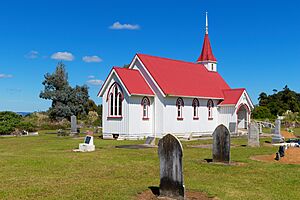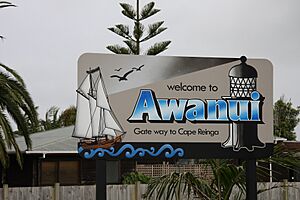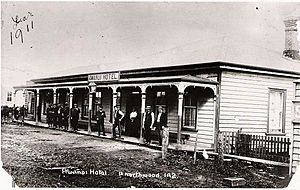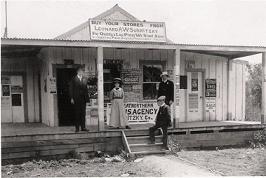Awanui facts for kids
Quick facts for kids
Awanui
|
|
|---|---|

St Josephs Church
|
|
| Country | New Zealand |
| Region | Northland Region |
| District | Far North District |
| Ward | Te Hiku |
| Community | Te Hiku |
| Subdivision | Whatuwhiwhi |
| Electorates |
|
| Area | |
| • Total | 0.96 km2 (0.37 sq mi) |
| Population
(June 2023)
|
|
| • Total | 620 |
| • Density | 646/km2 (1,673/sq mi) |
| Postcode |
0486
|
Awanui is a historic river port in the far north of New Zealand. It sits on the banks of the Awanui River, just before the river flows into Rangaunu Bay. Awanui is located at the southern end of the Aupouri Peninsula in the Far North District Council area, which is part of the Northland Region. It's about 7 km north of Kaitaia.
The old river port is no longer used for big ships. Now, a recreational wharf for smaller boats is at Unahi, about 3 km north of the town. The traditional name for this area was Kaiwaka, and Awanui actually means "the River at Kaiwaka." As of June 2023. , Awanui had an estimated population of 620 people.
The local Māori people, known as Tangata Whenua, have two important meeting places, called marae, nearby. Mahimaru Marae is on State Highway 10 and belongs to the Ngai Takoto hapu (sub-tribe). Further along State Highway 10 is Kareponia Marae, which belongs to the Patukoraha hapu of Ngati Kahu Iwi (tribe).
For most of the 1900s, Awanui was known for the Kaitaia Co-operative Dairy Factory. This factory was built in 1926 and included the wharf at Unahi. Over time, this dairy company merged with others, eventually becoming part of Fonterra. Because Awanui was far from major markets and farming technology improved, the factory closed in the early 1990s. Dairy farms still operate in the area, but the milk is now transported to a factory near Whangārei, about 100 km south.
In the 1920s, kauri timber and gum from Kaitaia were transported through Awanui to the coast. This was an important trade at the time.
Two main roads, State Highway 1 and State Highway 10, meet in Awanui. Nearby towns include Waiharara (16 km north-west), Kaingaroa (6 km north-east), and Kaitaia (7 km south).
Contents
History and Culture in Awanui
The Subritzky Family's Influence
In 1868, John Anton Subritzky and his family moved to New Zealand from Australia. They sailed to Auckland, then continued to Houhora. There, John's older brothers owned a large estate called Mount Camel Station.
Soon, the Subritzky family owned or controlled much of the land north of Awanui. They, along with their Māori and Pakeha family members, helped build the town of Awanui. Mount Camel Station was the center of their operations. For the next fifty years, they had a big impact on the Far North. They brought in cattle and even developed their own type of shorthorn cattle. They also started a shipping service to Auckland, helping many early settlers move to the northern areas.
The Subritzkys also built flax mills to process fibers for sale and export. Later, when the "gum diggers" were active, the gum trade became very important. This trade brought a lot of wealth to Northland throughout the late 1800s and early 1900s.
The Elingamite Shipwreck
On November 5, 1902, a large passenger ship called the Elingamite left Sydney, Australia, heading for Auckland. On the morning of November 9, the ship sailed into a thick fog. The crew slowed the engines, but it was too late. A lookout shouted "Breakers ahead!", but the ship hit the rocks of West King Island and broke apart.
The ship quickly filled with water. The crew launched all six lifeboats. The captain stayed with his ship until it sank, then he was rescued by a lifeboat. One lifeboat, led by Executive Officer L. Berkett, went to find help. They sailed around North Cape and down the east coast towards Houhora. They landed near Mount Camel. Some of the crew walked through the bush to the Houhora Hotel to get help. The Evans family at the hotel sent a telegram to Auckland, and a rescue fleet was sent out.
Ships like HMS Penguin, SS Omapere, and SS Clansman joined the search. The Subritzky family's own schooner, the Greyhound, also helped. Meanwhile, people in Houhora took action. They sent a rider to Awanui to tell the crew of the Greyhound, which was in port. They also knew that a passenger ship, the Zealandia, was sailing towards Australia and would pass Mount Camel soon. Members of the Wagener, Northwood, and McIntosh families went out in a whaleboat. They managed to stop the Zealandia and told its captain about the shipwreck. The Zealandia immediately sped off to help, leaving the tired whaleboat crew far out at sea.
On the evening of November 10, 1902, Captain Alfred Subritzky, who was in charge of the Greyhound, was asleep at his home in Awanui. His ship was tied up at the Subritzky wharf. He was woken by a rider on horseback shouting that the Elingamite had sunk at the Three Kings Islands.
Captain Subritzky knew the tides were low, making it hard to leave the harbor. But he quickly went to the Greyhound, woke his crew, and got ready to sail. They pushed the ship down the Awanui River. Then, they raised all the sails and used the auxiliary engine to get over the sandbar at the harbor entrance. The ship hit the bar with a big thump but managed to get over it. The Greyhound then raced north into the open sea to search for survivors.
The Three Kings Islands are at the very top of the North Island. The Greyhound was the first ship to start searching there. They found three men who had died in the water. Captain Subritzky wanted to give the bodies to another rescue ship, the SS Clansman, and keep searching. However, the Clansman captain refused to take them. So, the Greyhound had to return to Awanui because the bodies were starting to decay. The three men were buried in an unmarked grave at Saint Joseph's churchyard in Awanui by the Greyhound crew and Reverend Merton.
World War II and Awanui
During World War II, there was a Royal New Zealand Air Force airfield and base near Awanui, at Waipapakauri. After the war ended in 1945, the airbase was closed. Instead, the nearby Kaitaia Airport was developed with a paved runway, which was more suitable.
Marae in Awanui
Awanui has three important marae connected to Ngāi Takoto:
- Marae and its meeting house, Te Whakamomoringa.
- Te Pā a Parore Marae and its meeting house, Te Pā A Parore.
- Waimanoni Marae and its meeting house, Wikitoria.
There is also a marae linked to the Ngāti Kahu hapū (sub-tribe) of Patu Kōraha:
- Kareponia Marae and its meeting house, Patukoraha.
These marae are central to Māori culture and community life in the area.
Awanui's Population and People
Statistics New Zealand describes Awanui as a rural settlement. It covers about 0.96 square kilometers. As of June 2023, its estimated population was 620. Awanui is part of the larger Rangaunu Harbour statistical area.
In the 2023 New Zealand census, Awanui had 345 people. This was a small decrease from the 2018 census. There were slightly more females than males. The average age was 37.0 years. About 21.7% of the people were under 15 years old, and 17.4% were 65 or older.
People in Awanui come from different backgrounds. About 53.0% identified as European (Pākehā), and 71.3% identified as Māori. Some people identified with more than one ethnicity. Most people (94.8%) spoke English, and 13.0% spoke the Māori language.
Many people in Awanui identify as Christian (36.5%). Some follow Māori religious beliefs (13.0%). A large group (38.3%) said they had no religion.
For those aged 15 and older, about 7.8% had a university degree. Many (52.2%) had a certificate or diploma after high school. About 48.9% of people aged 15 and over were employed full-time.
Education in Awanui
Awanui has two schools that serve the local community:
- Awanui School is a primary school for students in years 1-6. It has a roll of 39 students as of February 2024. . Awanui School first opened in 1872 as a native school and moved to its current location in 1915.
- Te Rangi Āniwaniwa is a school that teaches students from years 1 to 15. It has a roll of 190 students as of February 2024. . Te Rangi Āniwaniwa opened in 1993 and teaches entirely in the Māori language.
Both schools are coeducational, meaning they teach both boys and girls.
See Also





